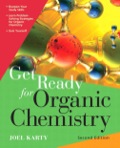
Concept explainers
Interpretation:
The two chair conformations of
Concept introduction:
Cyclohexane exists in two chair conformations which interconvert through a chair flip. The hydrogen atoms in cyclohexane are either in axial or equatorial positions. During chair flip, the hydrogens that were in an axial position are in the equatorial position and vice versa. However, the two chair conformers of cyclohexane are indistinguishable as all atoms bonded to the ring carbons are small hydrogen atoms.
In substituted cyclohexane, the larger size of the substituent atom or group reduces the stability of one of the conformations. Bulky groups require more space than hydrogen atoms and, therefore, are more stable in the equatorial position. A substituent in axial position is close to the two hydrogen atoms in axial positions on the same side of the ring. There are no such hydrogens in close proximity to a substituent in an equatorial position. This makes the equatorial conformer more stable.
Want to see the full answer?
Check out a sample textbook solution
Chapter 4 Solutions
EBK GET READY FOR ORGANIC CHEMISTRY
- Please predict the products for each of the following reactions: 1.03 2. H₂O NaNH, 1. n-BuLi 2. Mel A H₂ 10 9 0 H2SO4, H₂O HgSO4 Pd or Pt (catalyst) B 9 2 n-BuLi ♡ D2 (deuterium) Lindlar's Catalyst 1. NaNH2 2. EtBr Na, ND3 (deuterium) 2. H₂O2, NaOH 1. (Sia)2BH с Darrow_forwardin the scope of ontario SCH4U grade 12 course, please show ALL workarrow_forwardIs the chemical reaction CuCl42-(green) + 4H2O <==> Cu(H2O)42+(blue) + 4Cl- exothermic or endothermic?arrow_forward
- If we react tetraethoxypropane with hydrazine, what is the product obtained (explain its formula). State the reason why the corresponding dialdehyde is not used.arrow_forwarddrawing, no aiarrow_forwardIf CH3COCH2CH(OCH3)2 (4,4-dimethoxy-2-butanone) and hydrazine react, two isomeric products are formed. State their structure and which will be the majority.arrow_forward
- + Reset Provide the correct IUPAC name for the compound shown here. 4-methylhept-2-ene (Z)- (E)- 1-6-5-2-3-4- cyclo iso tert- sec- di tri hept hex oct meth eth pent ane yne ene ylarrow_forward+ Provide the correct IUPAC name for the compound shown here. Reset H3C H H C CH3 CH-CH3 1-3-methylpent ene trans- cis- 5-6-3-1-2-4- tert- tri sec- di cyclo iso but pent hex meth prop eth yl ane ene yne ☑arrow_forwarddrawing, no aiarrow_forward
 Organic Chemistry: A Guided InquiryChemistryISBN:9780618974122Author:Andrei StraumanisPublisher:Cengage Learning
Organic Chemistry: A Guided InquiryChemistryISBN:9780618974122Author:Andrei StraumanisPublisher:Cengage Learning
